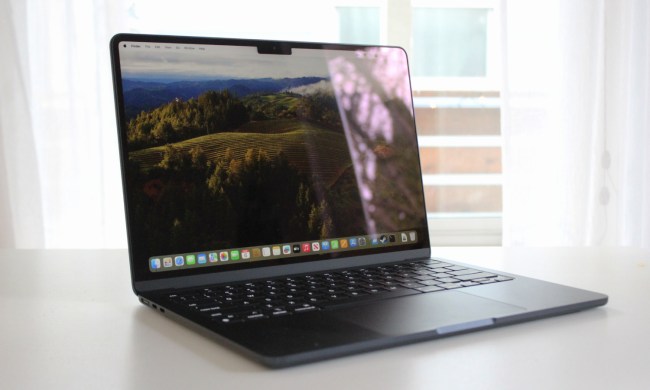Apple’s MacBook Pro 16 sits alone as the best content creation laptop you can buy today. It’s faster, more efficient, and better-built, and it has an awesome mini-LED display. It’s also very expensive, and of course it runs macOS.
That leaves an opening for a more affordable machine running Windows. Enter the Asus ProArt P16, which offers its own compelling advantages including good performance, a lovely OLED display, and attractive pricing. Is that enough to dethrone the best?
Specs and configurations
| Asus ProArt P16 | Apple MacBook Pro 16 | |
| Dimensions | 13.97 inches x 9.72 inches x 0.59-0.68 inches | 14.01 inches x 9.77 inches x 0.66 inches |
| Weight | 4.08 pounds | 4.8 pounds |
| Processor | AMD Ryzen AI 9 HX 370 | Apple M3 Pro (12-core) Apple M3 Max (14-core, 16-core) |
| Graphics | AMD Radeon 890M Nvidia GeForce RTX 4060 Nvidia GeForce RTX 4070 |
Apple M3 Pro (18-core) Apple M3 Max (30-core, 40-core) |
| RAM | 32GB 64GB |
18GB (M3 Pro) 36GB (M3 Max 14/30) 48GB (M3 Max 16/40) 64GB (M3 Max 16/40) 96GB (M3 Max 14/30) 128GB (M3 Max 16/40) |
| Display | 16.0-inch 16:10 4K+ (3840 x 2400) OLED, 60Hz | 16.2-inch 16:10 Liquid Retina XDR (3456 x 2234), 120Hz |
| Storage | 1TB SSD 2TB SSD |
512GB SSD 1TB SSD 2TB SSD 4TB SSD 8TB SSD |
| Touch | Yes | No |
| Ports | 1 x USB-C 3.2 Gen 2 1 x USB-C USB4 2 x USB-A 3.2 Gen 2 1 x HDMI 2.1 1 x 3.5mm audio jack 1 x SD card reader |
3 x USB-C 4 with Thunderbolt 4 1 x HDMI 2.0 1 x 3.5mm audio jack 1 x SD Card reader |
| Wireless | Wi-Fi 7 and Bluetooth 5.4 | Wi-Fi 6E and Bluetooth 5.3 |
| Webcam | 1080p with infrared camera for Windows 11 Hello facial recognition | 1080p |
| Operating system | Windows 11 | macOS Monterey |
| Battery | 90 watt-hour | 100 watt-hours |
| Price | $1,900+ | $2,499+ |
| Rating | 4.5 out of 5 stars | 4.5 out of 5 stars |
The ProArt P16 comes in a handful of configurations. The base model is $1,900 with the AMD Ryzen AI 9 370 HX chipset, 32GB of RAM, a 1TB SSD, an Nvidia GeForce RTX 4060, and a 16-inch 4K+ OLED display. It’s $2,700 with 64GB of RAM, a 2TB SSD, and an RTX 4070.
The MacBook Pro 16 starts at $2,499 with an M3 Pro chipset, 18GB of RAM, a 512GB SSD. and a 16.2-inch 3456 by 2234 mini-LED display. Upgrading to an M3 Max ups the price by $1,000, while increasing RAM to 36GB and storage to 1TB. At the very high end, the MacBook costs a whopping $7,199 with the fastest M3 Max, 128GB of RAM, and 8TB of storage.
Simply put, the ProArt P16 is a lot more affordable.
Design

The MacBook Pro 16 enjoys Apple’s fastidious design sensibilities, sharing the same simple yet elegant aesthetic and favors cohesiveness over ostentation. In short, it’s a gorgeous laptop that’s available in two colors, Silver and Space Black. The ProArt P16 is more pedestrian, with an all-black chassis and lines and angles that are more reminiscent of the typical laptop today. It’s not that the Asus isn’t attractive, it’s that it just doesn’t rise to the same level.
The same can be said about each laptop’s build quality. The MacBook Pro 16’s chassis is constructed from a single chunk of CNC machined aluminum. It and the lid are rigid, without any bending, flexing, or twisting. Its heft gives it a solid feeling that few laptops can duplicate. The ProArt P16 is also made of aluminum, but while its chassis and keyboard deck are reasonably rigid, the lid gives in to light pressure. The ProArt P16 feels plenty well built, but the MacBook is, again, on another level.
I don’t mean to pile on, but the MacBook’s Magic Keyboard is also better, primarily because of its snappier, more consistent switches. Both have large keycaps and plenty of key spacing, but the Magic Keyboard affords faster and more accurate typing. The MacBook’s huge Force Touch haptic touchpad is also much better than the ProArt P16’s smaller mechanical version. When it comes to entering data and navigating the UI, the MacBook Pro 16 is a better experience.
In terms of connectivity, both are mixed bags. The ProArt P16 has more legacy ports, but its single USB4 port provides less bandwidth than the MacBook Pro 16’s three Thunderbolt 4 ports. Both have HDMI, and both have full-size SD card readers. The ProArt P16 has more up-to-date wireless.
Both also have similar 1080p webcams, and both provide good images for videoconferencing. The ProArt P16 uses an infrared camera for Windows 11 Hello facial recognition, while the MacBook Pro 16 has a fingerprint reader embedded in the power supply.
Performance

The ProArt P16 is built around AMD’s latest chipset, the 28-watt Ryzen AI 9 370 HX with 12 cores and 24 threads. It’s a fast iteration of AMD’s Ryzen series, while incorporating the fastest neural processing unit (NPU) available running at 50 tera operations per second (TOPS). In addition, the ProArt P16 can be equipped with either the Nvidia GeForce RTX 4060 or RTX 4070 GPU. We reviewed it with the RTX 4070.
The MacBook Pro 16 uses either Apple’s M3 Pro or M3 Max chipsets. The M3 Pro has 12 CPU cores and 18 GPU cores, while the M3 Max comes in 14-core CPU/30-core GPU and 16-core CPU/40-core GPU variations. Our review used the fastest M3 Max.
Simply put, when equipped as we reviewed them, the MacBook Pro 16 is much faster than the ProArt P16. That’s most apparent in the Pugetbench Premiere Pro benchmark that utilizes several M3 Max CPU optimizations compared to the Windows version relying more on the GPU to speed things up. The only area where the ProArt P16 is faster is in gaming, where the MacBook is mostly held back by a dearth of modern titles that can take advantage of its GPU.
However, it’s important to note that a more comparable MacBook Pro 16 in terms of price will use the M3 Pro. That will make performance a lot closer.
| Geekbench 6 (single/multi) |
Handbrake (seconds) |
Cinebench R24 (single/multi/GPU) |
Pugetbench Premiere Pro |
|
| Asus ProArt P16 (Ryzen AI 9 HX 370 / RTX 4070) |
Bal: 2,688 / 14,497 Perf: 2,690 / 14,455 |
Bal: 50 Perf: 49 |
Bal: 114 / 1,165 / 11,184 Perf: 114 / 1,208 / 11,421 |
Bal: 5,444 Perf: 6,451 |
| Apple MacBook Pro 16 (M3 Max 16/40) |
Bal: 3,083 / 20,653 Perf: 3,119 / 20,865 |
Bal: 50 Perf: N/A |
Bal: 140 / 1,667 / 13,146 Perf: N/A |
Bal: 8,046 Perf: N/A |
Display

Here, we’re pitting OLED against mini-LED. That means we’re comparing OLED’s inky black and incredibly dynamic and accurate colors against mini-LED’s incredible brightness and high dynamic range (HDR) performance.
It’s a pretty intense battle. The ProArt P16’s OLED display is sharper at 4K+ (3840 by 2400) compared to the MacBook Pro 16’s 3456 by 2234 resolution. And the MacBook’s display also runs at up to 120Hz, making for a smoother experience.
According to our colorimeter, the ProArt P16’s OLED display isn’t even close to as bright, and both have deep contrast. But its colors are wider and slightly more accurate, and its blacks are perfect without the blooming effect that sometimes shows up with mini-LED.
Really, both displays are excellent for productivity users and creators. The MacBook Pro 16, though, has the best HDR in a laptop today thanks to its incredible HDR brightness that’s up to 1,600 nits.
| Asus ProArt P16 (OLED) |
Apple MacBook Pro 16 (mini-LED) |
|
| Brightness (nits) |
359 | 640 |
| AdobeRGB gamut | 98% | 89% |
| sRGB gamut | 100% | 100% |
| DCI-P3 gamut | 100% | 100% |
| Accuracy (DeltaE, lower is better) |
1.0 | 1.22 |
| Contrast ratio | 25,110:1 | 22,150:1 |
Portability

Both laptops are very close in size in width and depth, although the MacBook Pro fits in a slightly larger display thanks to smaller display bezels. Both are close to the same thickness, but the MacBook Pro 16 is considerably heavier. It will weight you a down a bit more than the ProArt P16.
Battery life, though, is a more significant differentiator. The ProArt P16 lasted for 8.5 hours in our web browsing test and 11 hours in our video looping test. That’s not bad for Windows creator laptops. However, the MacBook Pro 16 lasted for 19.5 hours and 27 hours, respectively. It’s the longest-lasting laptop we’ve tested.
Part of the difference comes from the MacBook Pro 16’s larger battery. Most, though, comes from the incredible efficiency of Apple’s M3 architecture. The MacBook will last you longer both when pushing it hard and when doing typical productivity tasks and media consumption.
The ProArt P16 is a great option for Windows users

Look, it’s simple: the MacBook Pro 16 remains the best 16-inch laptop around. It’s incredibly fast, it has awesome battery life, its build quality is second to none, and its mini-LED display is hard to beat. And it has a price tag to match.
The ProArt P16 is also pretty fast, it’s considerably lighter, and it has a great OLED display. It’s also a lot more affordable. If you’re a Windows user with MacBook envy, then the ProArt P16 is the go-to option.



